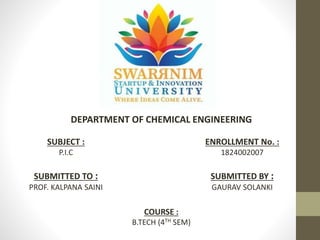
Nuclear Chemistry Fundamentals
- 1. DEPARTMENT OF CHEMICAL ENGINEERING SUBJECT : P.I.C ENROLLMENT No. : 1824002007 SUBMITTED TO : PROF. KALPANA SAINI SUBMITTED BY : GAURAV SOLANKI COURSE : B.TECH (4TH SEM)
- 2. TOPIC NAME : NUCLEAR CHEMISTRY • We are discuss about : • Radioactivity • Types of radiation • Properties of radiation • Detection and measurement of Radioactivity • Radioactivity decay • Rate of radioactivity decay • Units of radioactivity • Half life • Average life • Nuclear Reaction • Nuclear fusion reaction • Nuclear fission reaction • Nuclear Reactors
- 3. • Nuclear Chemistry : A study of the nuclear changes in atom is termed Nuclear chemistry. • Radioactivity : The decay of unstable atoms accompanied by emission of radiation is called radioactivity. • Types of radiation : There are 3 types of radiation . • 1) Alpha rays (α) : + • 2) Beta rays (β) : - • 3) Gama rays (γ) : Neutral Figure 1.0 : Detection of α, β, γ rays
- 4. Propertiesof radiation Radioactive Emanation Mass Charge Penetration Power Alpha 4 amu. 2+ little Beta ~0 amu. 1- middle Gamma No Mass No Charge Most(pure energy more than an X- ray) Figure 1.1 : Penetration power of α, β, γ rays
- 5. Detectionandmeasurementof radioactivity: 1. Cloud chamber : This technique is used for detecting radioactivity. The fundamental principle behind them is the super saturation of a vapor substance, a state in which the air, or any other gas, contains more vapour of that substance than it can hold in a stable equilibrium. Figure 1.2 : Principle of cloud chamber
- 6. • 2. Geiger-Muller counter : This device is used for detecting and measuring the rare of emission of alpha or beta particles . • It consists of a cylindrical metal tube(cathode) and a central wire (anode). • The tube is filled with argon gas for reducing pressure. • 1000 v is applied across the electrodes. • When alpha or beta particle enters the tube through the mica window, ionization of argon. Figure 1.2 :Geiger Muller counter
- 7. Radioactivity decay : The original nucleus is called the parent nucleus and the product is called the daughter nucleus • There are two chief types of decay : 1. α-Decay 2. β-Decay 1) α-Decay : Atomic mass = M-4 Atomic number = Z-2 • Example : 226 88Ra (parent) 220 86Rn (Daughter) 2) β-Decay : Atomic mass = M Atomic number = Z+1 • They are isotope of each other.
- 8. • Rate of radioactivity decay : Thus decay constant may be defined as the proportion of atoms of an isotope decaying per second. dN(t)/dt=−λN • N(t) is the amplitude of N after lapse of time t • λ is the decay rate constant. • Units of radioactivity decay : The standard unit of radioactivity is curie(c). 1 Rutherford = 10*6 dps 1 Bq = 1dps
- 9. Half life : The radioactive half-life for a given radioisotope is the time for half the radioactive nuclei in any sample to undergo radioactive decay. Figure 1.3 : Half life Calculation of Half life : t1/2 = 0.693/ λ
- 10. Average life : The statistical average of the lives of all atoms present at any time is called the Average life. Average life = 1.44 * half life Difference between : Nuclear Reaction and chemical Reaction Chemical Reaction Nuclear Reaction 1) Atom’s are rearrange . 1) Element’s are converted. 2)Electron’s are participate. 2) Protons, Nuetron, and Electron 3)Release small amount of energy. 3) Tremendous Energy. 4) Influenced by P,T,C 4) Not Influenced by P,T,C
- 11. Difference between : Nuclear fusion and Nuclear fission Nuclear fission Nuclear fusion 1) A bigger nucleus splits into smaller nuclei. 1)Lighter nuclei fuse together to form the heavier nucleus. 2) Does not require high temperature. 2) High temperature require. 3) A chain reaction. 3) It’s not a chain reaction. 4)It can be controlled. 4)It cannot be controlled. 5)The products of the reaction are radioactive in nature. 5)The products of the reaction are not radioactive in nature.
- 12. NuclearReactors:Controlledfissioniscarriedoutinaspecially designedplantcalledanuclearreactors. 1) Nuclear fuels : They are made from enriched uranium oxide . This contains approximately 3-4% U-235. The fuel is then converted into small pellets, packed into tubes called pins. The pins are bundled into larger tubes and are ready to be put into the reactor. 2) Moderators : Moderators slow down the neutrons. Materials used for moderators include graphite and heavy water, containing the isotope deuterium (H-2). 3) Control rods : Which control the rate of fission U-235. these are made of boron-10 or cadmium . 4) Coolant : Which cools the fuel core by removing heat produced by fission.D2O is more efficient that light water. 5) Concrete shield : Which protects the seperating personnel and environments from destruction.
- 13. Figure 1.4 : Nuclear reactor plant
- 14. Thank You
- 15. References • http://www.kentchemistry.com/links/Nuclear/AlphaBetaGam ma.htm • https://www.osha.gov/SLTC/radiationionizing/background.ht ml • http://www.kentchemistry.com/links/Nuclear/AlphaBetaGam ma.htm • https://www.scienceabc.com/innovation/what-is-a-wilson- cloud-chamber.html • https://www.studyandscore.com • https://in.images.search.yahoo.com • https://upload.wikimedia.org